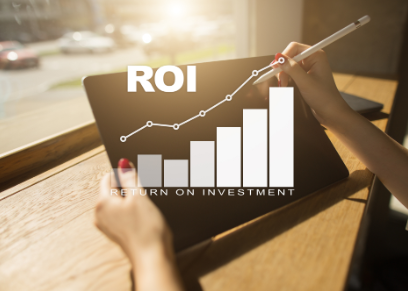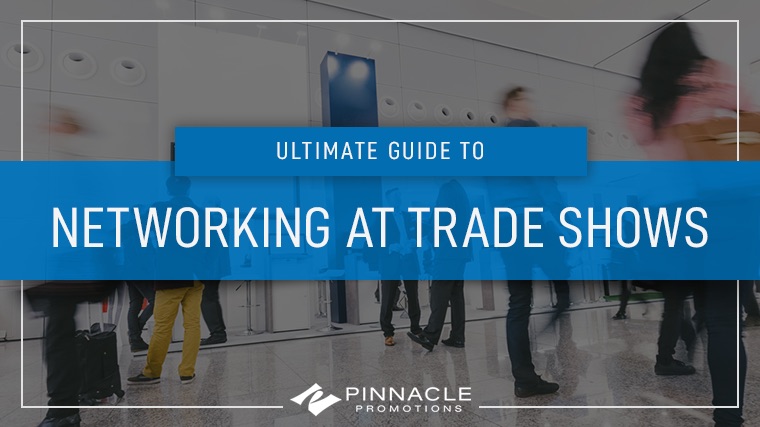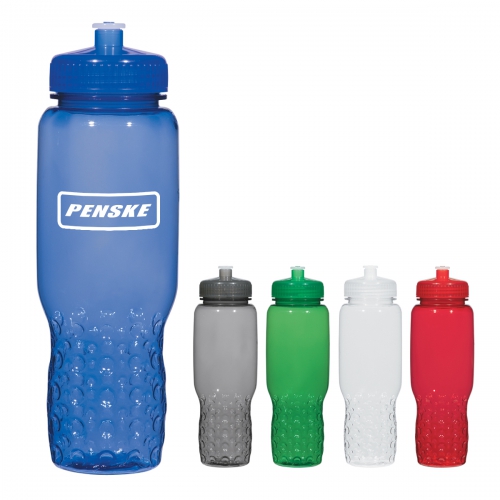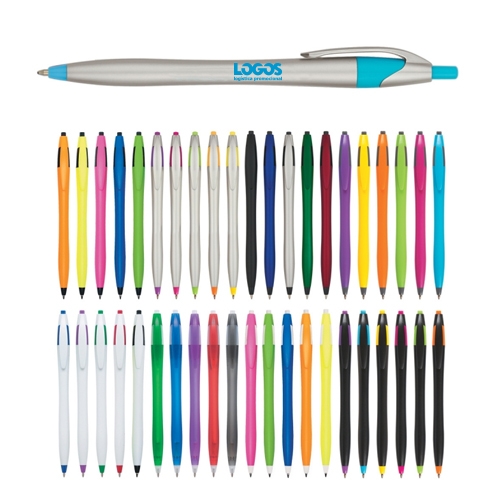It’s summertime and Merchandising Manager Sarah shows you her favorite products for your next company picnic or outdoor event.
Lee
Ultimate Guide to Networking at Trade Shows
Trade Shows 101
When it comes to face-to-face marketing, few events can rival the ROI potential of a trade show. With the right marketing strategies and careful planning, a quality trade show can put your brand smack dab in front of a targeted audience who is searching for a product or service just like yours.
But what is a trade show, exactly? While you’ve likely walked through a crowded exhibit or convention at some point in your life, being on the other end of the display booth is a much different experience than being an attendee.
Before we dive right in, here is a quick primer on what you should know about trade shows:
- Trade shows can benefit companies both large and small by putting their brand directly in front of qualified leads.
- When used correctly as trade show handouts, promotional items can be extremely effective at generating qualified leads and meeting your company goals.
What Is a Trade Show?
Trade shows are exhibition events held in major cities where exhibitors in a specific industry set up a display booth to promote their products and services. Usually, trade show attendees must either pay to get into the event or be invited to the show, making them far more valuable of a lead than the average Joe off the street. These people have a vested interest in the products and services on display, which is one big reason why an estimated 1.3 million exhibitors set up a trade show display booth in 2014, according to a 2018 CEIR Index.

Why Make Trade Shows Part of Your Marketing Plan?
Whether you’re trying to grow your brand awareness or break into the industry via smart networking tactics, trade shows have the potential to scale your business and grow your brand. Let’s look at a few specific reasons why business executives and entrepreneurs prioritize industry trade shows:
-
- In-Person Interaction—In an age of social media, the value of face-to-face interaction shouldn’t be dismissed. In-person interaction is essential to making meaningful connections with attendees and moving them down the marketing funnel.Attendee Buying Power—According to The Exhibit Survey, more than 80 percent of trade show attendees have buying power. Attendees are ripe for the taking, but only if you can draw them to your booth.
-
- High ROI—While the return-on-investment of trade shows can vary depending on industry, it’s not uncommon for businesses to come away from their trade show with a huge profit. According to atEvent, companies can expect to achieve an average ROI of $4.99 for every dollar they invest.
-
- Boost Brand Awareness—From promising startups to established corporations, trade shows can be used by any size of business to grow their brand awareness and connect with their target market.

6 Steps to Make Your Next Trade Show a Success
There is a lot that goes into planning for an upcoming trade show. From researching shows to determining objectives, here is a brief look at what goes into achieving trade show success:
- Determine Goals—If you don’t have a goal for your trade show, how will you measure your success? Determining goals early is crucial to making your trade show a huge success. A few ideas of trade show objectives include boosting brand awareness, promoting the launch of a new product or growing authority in a particular niche.
- Craft a Budget—How much will you need to invest to accomplish your goal? Creating a trade show budget can be tricky, but it will help ensure that you’re investing your time and money wisely.
- Find a Quality Trade Show—Research trade shows in advance to make sure that each one is worth your investment.
- Research the Competition—Who are your biggest competitors at the trade show? Research their selling points and find ways to outshine them on the trade show floor. From flashy signage to unique promotional products, get creative with your trade show strategies.
- Attract People to Your Booth—Give people a reason to stop by your booth with exciting signage, engaging booth staff and, of course, trade show giveaways. Attendees have come to expect branded swag at trade shows, so be sure to check out our trade show swag ideas if you need some inspiration for your booth.
- Follow-Up with Leads—Don’t wait for leads to lose interest in your brand. Follow up within 24 hours while your brand is still fresh on their minds.
Make a Lasting Impression at Your Next Trade Show
When you’re new to the trade show industry, exhibiting for the first time can be stressful. From developing an eye-catching booth to crafting the right messaging, you’ll probably be spending a lot of time, money and energy into your upcoming trade show.
While we can’t take away all of your trade show stress, we can make it easy to attract attendees with useful promotional products that are the talk of the trade show. Get in touch with us and we’ll help you pick promotional items that align with your brand messaging and help you maximize your trade show ROI.
What Does “Swag Bag” Mean and What Items Should you Include?
If you’ve ever left a networking event or trade show with a goodie bag loaded with promotional items, then you have some familiarity with a swag bag. A quality swag bag has the potential to delight event attendees and keep your business top of mind long after the event has passed.
So, What is a Swag Bag?
But let’s rewind for a minute: What is a swag bag? What does “swag” even mean? Briefly, here is what you need to know about the meaning of swag bags:
- Swag is an acronym for “Stuff We All Get.”
- Swag refers to promotional items that companies hand out to attendees as a form of advertising.
- To delight attendees with a swag bag, event managers and marketers must develop an effective promotional strategy.
A Brief History of Swag Bags
“Swag” isn’t a new term. In fact, it’s not even a new concept. We’ve been giving out swag since the 1700s, and at funerals, of all places!
While the meaning of swag has steadily evolved over the years, the goodie bag we know and love today first arose during the dot com bubble. They gained widespread attention thanks to the Oscars and the Emmys, which were known for giving out swanky, lavish gift bags as a consolation prize for all the nominees.
Today, swag bags are used for a variety of events, from fun runs and races to conferences to fundraisers and everything in between. Whether you’re a startup trying to create brand familiarity or an established company wanting to generate buzz for a new product, a swag bag can be an extremely effective marketing strategy for your business.
How Your Business Can Benefit from a Quality Swag Bag
Swag bags are not just fun; they’re a strategic tool in brand promotion. Look around your office—you likely have several promotional items within reach. These aren’t just useful tools; they’re constant reminders of the brands they represent.
Brand Recall
A study by the Advertising Specialty Institute shows that 85% of people remember the advertiser that gave them a promotional item, making swag an effective memory hook.
Customer Loyalty
Over one-third of people who receive promotional items are more likely to do business with the company that gave it to them, enhancing customer loyalty.
Cost-Effective Marketing
Swag bags provide a more budget-friendly alternative to costly advertising methods like TV or radio, perfect for companies with limited marketing budgets.
Enhanced Visibility
Every time someone uses a promotional pen, wears a branded t-shirt, or carries a tote bag, your brand gets exposure far beyond the initial recipient.
Perceived Value
Well-chosen swag can feel like a thoughtful gift, increasing the perceived value of doing business with your brand.
Versatility
Swag can be tailored to fit any event or audience, making it versatile for any promotional need.
Sustainable Options
Offering eco-friendly promotional products can improve your brand’s image and appeal to a more environmentally conscious consumer base.
Community Engagement
Swag bags can be used to support local events, charities, and schools, showing your business’s commitment to community involvement.
Employee Morale
Swag isn’t just for customers. It can also boost employee morale and create a sense of belonging within a company.
Trade Show Traffic
At trade shows, a compelling swag bag can draw attendees to your booth, increasing leads and potential sales.
Swag bags offer a unique combination of practicality and promotional power, helping to cement your brand in the minds of consumers and encouraging both loyalty and new customer acquisition. Invest in quality swag to reap the benefits of an affordable yet impactful marketing strategy.
Swag Bag Items
Swag bags, much like those delightful goodie bags from childhood parties, contain a variety of promotional items and samples aimed at leaving a memorable impression. They often feature branded gifts that recipients can use, promoting prolonged brand exposure.
Custom Power Banks
Keep your recipients powered up with custom power banks. They’re perfect for charging devices on the go, making your brand a daily convenience in their lives.
Recycled Paper Journals
Offer a sustainable choice with journals made from recycled paper. They’re ideal for note-taking at conferences or daily planning, showing your brand’s eco-conscious side.
Branded Tote Bags
Durable and reusable, these tote bags extend your brand’s reach every time they’re used for shopping or carrying essentials.
Personalized Water Bottles
Keep attendees hydrated with water bottles customized with your logo. They’re practical for both gym goers and office workers.
Custom USB Drives
Share your brand digitally with custom USB drives. Load them with your company’s portfolio or presentations to make a professional impact.
Branded T-shirts
Create walking billboards with stylish, comfortable T-shirts featuring your logo. They’re great for team events or as casual wear.
Promotional Sunglasses
Add a fun touch to outdoor events with sunglasses that protect eyes and showcase your brand on sunny days.
Eco-Friendly Straws
Show your commitment to the environment with reusable straws. Pair them with your logo for a green message.
Portable Bluetooth Speakers
Let your brand be the life of the party with portable speakers that carry your logo and deliver great sound.
Custom Stress Balls
Offer a way to de-stress with squishy, branded stress balls. They’re perfect for office environments and trade shows.
Swag items are more than just gifts; they’re a strategic marketing tool that enhances visibility and engagement. Choose items that resonate with your audience and reflect your brand values to make your swag bags a hit.
A Few Tips Before We Go
It’s clear that swag bags can create brand familiarity and delight event attendees. They also have the potential to be a massive disappointment and a waste of money if event managers don’t know what they’re doing.
Before you order cool swag items for your swag bag, remember that your items need to be useful, relevant and align with your brand. Why not check out our best sellers for more inspiration before you go and if you need help choosing promotional products that will give you the best bang for your buck, we’re happy to help! Get in touch with us and we’ll help you create a swag bag that makes a lasting impression on your target audience.
Sarah Selects: Eco-Friendly Products
Merchandising Manager Sarah is here to help you save the environment while promoting your brand with her favorite eco-friendly and sustainable products. #savetheturtles
Inexpensive Promotional Products
What to Wear to a Conference – Trade Show Attire Tips from the Pros
Ways to Make Your Company a More Sustainable Workplace
Company Events: A Perfect Place to Use Promo Products
Sometimes your own employees can be the best source for spreading brand awareness through promotional products. Many companies offer new employee welcome kits filled with essential information and promotional gifts with their brand logo to encourage staff to support and represent the business.
Everybody loves receiving free swag, so be sure to order bulk promotional items that your team will appreciate and want to use even outside the office. Hosting team-building company events is another great time to distribute promotional products and build a positive office culture. Follow our tips to create a memorable company event that will spread brand awareness and overall benefit your business.
Benefits of hosting a company event
1. Create a strong company culture
Fostering a distinct company culture is important for employee retention as well as building your brand because it aligns the values of your staff and your company. If you create an office environment that your employees genuinely enjoy, they are much more likely to remain loyal while also spreading the word about how well your company operates. According to Forbes, 87 percent of people who feel that their company encourages engagement are more likely to stay with the company.
When employees are more satisfied and engaged, they are also likely to be more motivated and produce higher quality work. A company event is a perfect opportunity to demonstrate your company’s culture in action. As you plan the event, consider what core values you can emphasize to your staff and brainstorm ways to demonstrate these principles. During the event, give away promotional items to show your employees your appreciation for them.

2. Encourage teamwork
Without hosting company events, it can be difficult for employees to find time outside of work to mingle with other staff. These festivities provide your team with the chance to relax and connect without the pressures of office duties. When employees have the opportunity to speak in a social setting, they form stronger bonds, which encourages better working relationships.
Not only do company events allow colleagues to interact, but they also open the door for communication between leadership and employees. Sometimes management may seem unapproachable because they are in a position of authority and employees, particularly new hires, don’t always feel comfortable turning to them with a problem. In a low-stress setting such as a company event, employees have the chance to get to know their bosses better and feel more collegial, making it easier to approach them in the office with work concerns.
3. Demonstrate employee value
When employees feel as though their contributions to the company are important, they are much more productive, motivated and happy in the workplace. Throwing a special company party is an excellent way to display your gratitude for each of your staff members. Many companies opt to host an Awards Ceremony event each year to personally reward employees that have done an outstanding job over the course of the year. This type of company event is fun for everyone and provides the recognition many employees seek.
When planning a company event, you should build in a time to gift your team with useful and high-quality promotional products. These gifts are another token of your appreciation and work well as visual advertisements to others.
The perfect bulk promotional items for company events
Personalized shirts and other apparel
Personalized shirts are popular and valuable promotional items to distribute to employees. They can be worn to work on casual days as well as outside the office. Seek out high-quality apparel, like custom embroidered jackets from reputable brands such as Columbia and Under Armour, and customize them with your company logo.
Corporate gifts and awards

If you’re planning to host a company-wide Awards Ceremony, you’ll need gifts and awards to give out to your winners. A traditional award like a plaque is an excellent way to make your outstanding employees feel special, but you can also opt to offer other types of prizes such as custom Yeti tumblers or branded Wrapsody headphones.
Custom drinkware
To commemorate a great company event, hand out beautiful custom glassware that your employees can take home and use for years to come. Custom wine glasses with your company logo and the name of the event are classy favors that people will love. You can also consider giving away something people can use every day such as coffee mugs with your company logo.
Marketing Ideas that Don’t Break the Bank
If you’re just getting your business off the ground, you’re probably wondering how you can introduce your startup to your target market without spending too much money on expensive marketing tactics. Luckily, small business owners have more opportunities than ever to get their brands in front of the right audiences, particularly with the use of promotional products.
These customizable items are affordable and effective methods for capturing the attention of potential customers. While most companies opt to give out bulk promotional items at events, trade shows or to new clients, there are plenty of other ways you can get your custom promotional products into the hands of the right people. Test out some of these affordable marketing techniques to increase awareness of your brand.
1. Host a social media giveaway contest

People of all ages interact with brands on social networks on a daily basis. Because so many people are exposed to these sites each day, social media platforms have become extremely important for advertising and marketing efforts. While some people prefer to run sponsored social media ads, if you’re looking for a cheaper way to get your business noticed on social media, you can run a giveaway contest. There are specific laws that regulate giveaway contests via social media, so be sure to read up on these important rules before planning the contest.
Before you are able to run a promotional contest, you must first have an account on a social media platform (or platforms). When selecting where to host your competition, you should consider your target demographic and which sites they are most likely engaging with. Create a thoughtful post announcing the contest along with a photo of the bulk promotional product you will be giving away.
Instagram is a well-liked platform for these types of competitions. Most businesses require contestants to follow their page, tag a friend or two and sometimes include a hashtag in their post in order to qualify. These rules are effective because they require people to follow your business on social media. This will provide your company with the opportunity to engage with these new followers and show them what your brand is all about.
2. Team up with another company in your industry
Sometimes forming alliances with other companies within your industry can benefit both parties. Organize a low-key, affordable event with another company to promote each other’s brands. During the event, each respective party will be able to interact with the other’s customers, spreading their companies’ messages to people already familiar and interested in the industry.
At this event, you can help attendees to remember your business through promotional products given away at the door. When teaming up with another company, you want to make sure that you are in related businesses but not direct competitors as that can make things confusing for consumers and hinder your potential business prospects. One popular example of this type of co-branding is GoPro and Red Bull. Though the two companies sell different products, their target markets tend to overlap, so they have formed a global partnership through which they host thousands of events each year.
3. Get featured on a popular blog or vlog
Blogs are effective at spreading the word about everything from breaking news to the latest trends. Even if your company has its own blog, you should seek out other more popular bloggers in your field that would be willing to include a special review or guest post on their site, which will in turn draw attention back to your company’s website. In exchange for the favor, you can offer bloggers quality promotional products or allow them to give away one of your branded t-shirts or other promotional product via their blog.
4. Get involved in your local community
Earning the support of your local community is vital to creating customer loyalty and brand credibility. Event booth rental and/or sponsorship can be expensive but there are dozens of free or low-budget volunteer opportunities at local events. Even if you are not looking to be a vendor at an event, you can always reach out to event planners looking for in-kind donations of take-home items (also known as “swag bag” items) for guests. Although attendees may not have had the chance to talk with one of your employees face-to-face, they will have a unique item with your company’s brand to take home for future use.
5. Promote exclusive promotional products
Exclusivity is an excellent sales method because everyone enjoys feeling special. If potential customers think that they are getting access to something others are not, they are much more likely to make a purchase from your company or simply engage with your brand on social media. Regardless of what platform you use to offer an exclusive promotional product, be sure to use language that makes it clear this special is not available to everybody. For example, Victoria’s Secret often hosts sales exclusively for Angel Cardholders, which also include a free branded item when cardholders make a purchase.





























